I’m cautiously optimistic that a breakthrough has just emerged to do with the Art History origins of the Voynich Manuscript’s puzzling zodiac pages, that would appear to connect them with Diebold Lauber’s fifteenth century manuscript copying house. Errrm… who he? I’ll explain…
The Voynich Zodiac section
Even though we cannot decrypt the Voynich Manuscript’s text, researchers have long noted that its illustrations strongly suggest that the manuscript isn’t just random, but is instead composed of a number of thematically-connected sections.
The Voynich zodiac section contains a series of roundels depicting the signs of the zodiac (though the folio at the end containing Capricorn and Aquarius has without any real doubt been removed). Each roundel is surrounded by 15 or 30 small naked women (‘zodiac nymphs’, though Pisces has only 29) posed somewhat awkwardly, each of whom is linked to a small fragment of text (‘zodiac labels’). Here’s Pisces:
[Note that one early owner seems to have added month names to its roundels (e.g. March to Pisces, April to Aries, etc) in a somewhat rough and ready hand, but that’s another matter entirely.]
I’ve argued for years (and the idea certainly wasn’t mine) that the central drawings were probably loosely copied from an astronomical calendar or hausbuch, of the type entirely typical of late 14th or early 15th century Germany, a good number of which had strikingly similar circular astrological or astronomical roundels.
But despite Voynich researchers’ Herculean efforts in recent years to cross-reference these medical/astronomical hausbuch drawings to the Voynich’s zodiac drawings, results have been mixed at best: a zodiac sequence with a good Pisces or Sagittarius match would for the other zodiac signs typically be accompanied by drawings that shared practically no similarities with the Voynich’s roundels. And so things, after a huge burst of collective enthusiasm a couple of years back, stalled somewhat.
Enter Koen Gheuens
In 2016, researcher Koen Gheuens was looking at the Voynich zodiac Gemini roundel drawing, and wondered what the curious double-handed handshake gesture depicted there might signify or mean.
After the usual long sequence of dead-ends, he discovered that in fact it was a pose used in some medieval weddings, and that it even had its own literature. He describes it as follows:
The type of medieval marriage we’re interested in is as follows: the man and woman hold one hand (in cross, so left to left or right to right) and with his free hand, the man puts a ring on a finger of the woman’s free hand. This results in the “double handshake” look. The “passive” set of hands is usually pictured below, while the putting on of the ring is above.
Koen found a number of depictions of the double-handed marriage – very ably documented on his Voynich Temple website – which progressively led him to the manuscript workshop of Diebold Lauber.
Diebold Lauber
In the days before printing, manuscript workshops had to find ways of churning out work for clients that was cost-effective: drawings in particular were time-consuming. The particular ‘hack’ Diebold Lauber’s workshop seems to have made most use of was to have a set of pre-drawn generic exemplar poses which were then lightly adapted (presumably by less skilled illustrators) multiple times. In this way, drawings were reused and recycled multiple times: the connections between these recycled drawings gives plenty of grist for Art Historians’ mills to grind.
Koen put forward the idea that there seems to be a connection between a particular Diebold Lauber crossed-hands-marriage drawing dated to 1448 and the Voynich zodiac crossed-hands Gemini roundel:
And once you see how the details parallel each other, it is indeed a very persuasive visual argument (Koen’s composite image):
Putting all the pieces of the historical puzzle together, it would therefore seem a perfectly reasonable inference that the Voynich zodiac roundel drawings were roughly copied from a zodiac sequence that appeared in an medical-astronomical hausbuch commissioned from Diebold Lauber’s manuscript workshop, where the Gemini pose had been recycled from an earlier Diebold Lauber crossed-hands marriage stock drawing exemplar.
Diebold Lauber References
For a German-language description of Lauber’s prolific workshop in Hagenau (just North of Strasbourg), the Ruprecht-Karls University of Heidelberg has put together a nice page here. From this we learn that researchers have collected together about 80 examples of the workshop’s output dating from 1427 to 1467 (lists here): and that the illustrators worked as long-standing teams, with the so-called “Gruppe A” active from about 1425 to 1450. Lauber was effectively a bookseller, and even included a handwritten advertisement in some of his manuscripts, such as this one (from Cod. Pal. germ. 314, fol. 4ar) from 1443-1449:
A transcription and translation of this would be much appreciated! 🙂
A Diebold Lauber Calendar
What might a Diebold Lauber medical/astronomical calendar look like? Luckily, we don’t need to wonder: there was one in the library of Colonel David McCandless McKell in Lexington, Kentucky, that Rosy Schilling wrote two short books about (one a facsimile of the MS, the other a transcription and English translation).
* Rosy Schilling: A facsimile of an Astronomical medical calendar in German (Studio of Diebolt Lauber at Hagenau, about 1430 – 1450): from the Library of Colonel David McC. McKell, Lexington, Ky., 1958
* Rosy Schilling: Astronomical medical calendar: German, studio of Diebolt Lauber at Hagenau, 15th century, c. 1430 – 50, Lexington, 1958
Here’s what January looks like (i.e. Aquarius):
And – because I know you’re going to ask – here are all twelve zodiac signs from the McKell Ms (click for a larger version):
McKell’s extensive library was bequeathed to the Ross County Historical Society, though according to the Handschriftcensus entry, it was sold by Bloomsbury Auctions (8th July 2015, Sale No. 36180) to Dr. Jörn Günther Rare Books AG. So anyone suitably rich who wants to own this can very probably do so. Which is nice.
So… What Next?
Personally, I’m not convinced every extant Diebold Lauber workshop drawing has been collected together yet. For example, Biblioteca Apostolica Vaticana, Pal. lat. 1370 has been mentioned before by Voynich researchers on one of Stephen Bax’s pages (it was written in Strasbourg in the mid-15th century, certainly before 1467): and I would be unsurprised if it was connected with Lauber. Here is its Sagittarius roundel:
I’m also far from convinced – given that medical/astronomical hausbuchen don’t have a huge literature – that there aren’t other Diebold Lauber calendars out there that haven’t yet been recognized for what they are. Perhaps this should be a good direction to pursue next? Something to consider, anyway.

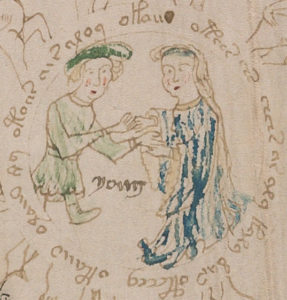
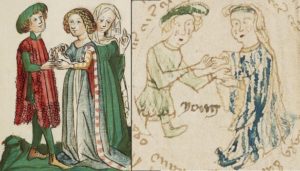
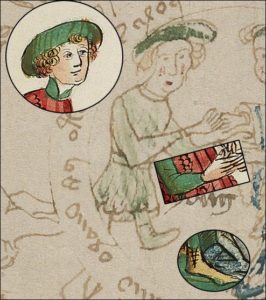
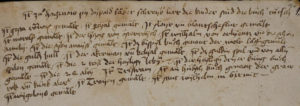
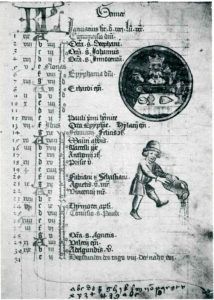

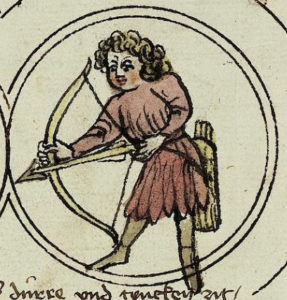
This is essentially a copy of a message I posted in the Voynich Ninja forum.
– – – –
The topic is now appearing in several different places, and inevitably, discussions will be going on in parallel.
I see some very interesting and credible things in it, but also some more speculative and hasty considerations.
For me, it is completely convincing that the crossed arms are intentional, and derive from existing illustrations related to courtly love/marriage and the exchange of rings.
It is also right to search for possible precedents of this, but this cannot be done in just a couple of days.
One important question for the Voynch MS is whether the zodiac cycle as a whole was copied from one source MS, or it was put together from different sources. I daresay that this question cannot be answered yet, and it should be kept open. It would be dangerous to make assumptions about it, and use these assumptions to direct the search for precedents. The Voynich MS draughtsman may have been drawing from memory, combining things he had seen in different places. For the scorpio, there has not yet been any close precedent.
I find the possible precedent of the Hagenau workshop(s) far less convincing.
Of course, a priori, there is nothing against them. They do not create any inconsistency with what has been observed before, related to place or time. However, as far as I have seen:
– they didn’t actually create new illustration types, just copied existing ones, with slight modifications. As such, one should also try to find their precedents.
– I have not seen one image of a crossed-arms couple in their output (maybe I overlooked it). This is the key feature that should be relevant.
The fact that there are some images with similar clothing and similar colours cannot be sufficient, because this is likely to be found throughout central Europe during this time.
A more general search is needed, and Marco already found an interesting example in another thread (of the Voynich Ninja).
As Gemini is “the twins”, showing a wedding ceremony for the illustration seems a little perverse? Could it be that the artist had just searched for a “suitable” reference image without really knowing what it was depicting?
Tiger of Darkness: reusing vaguely similar images was something that these busy workshop artists did all the time, yes, even if marrying your twin didn’t make a lot of sense.
Unless you were some kind of European royal family, of course, when that would be counted as third cousins. 😉
At Hagenau, Diepold Lauber, scribe, teaches the children. These are the books in German
* Gesta Romanorum with illustrations
* Fleur and Blanchefleur w.i.
* Morolf w.i.
* Duke of Austria.
* William of Orleans and the beautiful Amelie,
* Seven masters w.i.
* The Book of Examples called The Way of the World w.i.
* Golden Bull
* Ploughman and Belial w.i.
* Golden Game and illustrations of all games w.i.
* The two parts of the Saints’ Lives
* Book of the the three Magi, w.i.
* the 24 Old Men
* Tristram
* a nice book called the grey cloak and King Alexander
* Troy w.i.
* Saint William in Birmit
* Wigalois w.i.
Some people will criticize the use of the diacritics, some of the Id‘s of the books are obvious, for some others someone would have to do some work.
I would suggest that anyone looking at possible parallels between the VMS and the work of (or connections to) Lauber-related studios should also look at Das Buch der Natur (in terms of palette, some of the drawing quirks associated with the hind limbs of animals, and some of the subject matter):
https://voynichportal.com/2016/01/25/sirens-and-sailors-and-the-lovely-melusina/
Rene: unlike most of the specious imagery parallels I normally get presented with (where you have to squint so hard that your eyes nearly pop out), the similarities here seem to me to push the comparison into an entirely different category. And given that we are talking about a busy mid-fifteenth century German copy shop that we know also made at least one zodiac calendar, I’m feeling quite comfortable that we’re basically in the right place here (or, at least, extremely close to it).
The reason that I think we can largely discount the Voynich author’s having culled zodiac images from a variety of sources is that they are all (a) very similar to each other (they all basically look 50-100 years older than everything else in the manuscript), and (b) very different to the rest of the drawings in the Voynich. I’m not saying it’s impossible, of course, but the default position really ought to be that these all probably arrived as a group.
I’m not saying for a moment that this is the end of the research line: in fact, I’m saying the opposite, insofar as I think this gives us a very strong clue as to exactly what we should be looking for. So I think we need a wider search for something far more specific, if that makes sense.
Helmut: thank you very much indeed, I very much appreciate it. Because the list of entries all began ‘item’, I lightly edited your English translation so that each item was on a different line, hopefully this will be more useful to anyone looking to work with these.
Personally, I assume, whichever author must have had some kind of study or course.
I do not know what it was then, but today many students come from different regions and cultures.
Actually, they teach everything the same, and then take their knowledge with them to their original regions.
The core question:
How was that then, and how far may I include coincidences.
Right now I think the fact that has been demonstrated most clearly is that the Gemini are proper to “courtly” literature much more so than to “astro”-imagery. We’ve got two or three appearances of the crossed arms or something resembling them in astrological contexts, but there the figures are always naked. In one case we’re dealing with a clear Adam and Eve type, which stands far from the VM.
One thing to keep in mind is that despite the similarities and clear relatedness, the Alsacian pairs never really cross their arms, they were uncrossed from the example. As you know, this is the kind of thing Lauber and peers routinely do.
I don’t see the VM artist capable of re-crossing the arms. Hence, I think the VM image was copied from the same model (or very similar) used by Lauber. Marco shared an interesting example on the forum which suggests that French courtly imagery might be worth a new look.
https://www.voynich.ninja/thread-591-post-22190.html#pid22190
About unattributed Lauber MSS: one thing I noticed is that, differently from the VM marginalia script, Lauber’s scribes tend to completely loop the ascender on the “d”, resulting in an 8. I didn’t do an exhaustive study, so counterexamples may exist. The script in the manuscript you propose looks different (stick ascender).
But you are talking about the image, of which I agree it has an undeniable Haguenau flair 😉
Nick
I do not think the “item” is English, but the old German for “in the”
If I am in a very simple way trying to draw from this what can be of general interest to Voynich researchers I would guess that it is that this information serves as a geographical marker as this kind of drawing would really only appear in a limited area. So for example if someone hypothesizes that the manuscript is Turkish then this particular drawing would seem to be at odds with that as would other drawings I think. The second is that this may help to isolate a source for the astronomical section of the Voynich, there doesn’t seem to be a general consensus yet as to what and where a source for the drawing could ne found.
Is that the general opinion??
Are we saying that manuscripts containing this form of representation would have been found only in a very specific area, say near Strasbourg, or could they have been found all over Europe?
Mark: what I’ve said for more than a decade is that the Voynich’s zodiac roundel drawings appear to me to have been copied (albeit fairly ineptly) en masse from a single (probably German) calendar of the late fourteenth or early fifteenth century. What’s different here is that it now seems quite likely to me that the particular calendar was from Diebold Lauber’s workshop.
All the same, this could have been copied by anyone anywhere in Europe, so you have to be careful what you think you’re inferring. 🙂
Great scholarship but one question immediately congeals my cranium from going any farther with the European origin presumption:
Why would someone use GAR fish, native and unique to Meso-America, to illustrate Pisces ?
James Pannozzi: if that’s a sticking point for you, then I can see how you would find yourself quite solidly stuck. 🙂
VMS Pisces doesn’t especially resemble the gar fish. It doesn’t have a front dorsel fin.
https://voynichportal.com/2018/09/05/not-nahuatl/
And for the researchers to insist that the large fish in the pond, which looks nothing like the VMS Pisces fish and nothing at all like an alligator gar, is the same kind of fish, makes no sense at all.
JKP: Sounds like you are a “Meso-America” doubter. Well, what do you think about the “mahi mahi” fish found off Easter Island and its resemblance?
Nick: So to simplify again, you see this as possibly a significant step in locating a zodiac block paradigm, but really serving no purpose as a geographical marker other than further implying a connection to European culture.
Is that right?
Mark: I’m not really sure yet. It might give us dating information, it might give us geography, it might open our eyes to the crowns, it might tell us what to look for, etc.
Mark Knowles wrote: “JKP: Sounds like you are a “Meso-America” doubter. Well, what do you think about the “mahi mahi” fish found off Easter Island and its resemblance?”
No, sorry, that’s a complete misinterpretation of my viewpoint.
I have never indicated that I am a Meso-American doubter. You should not assume because I disagree with specific IDs that I am throwing New World theories out the window.
When I do plant and animal IDs I ALWAYS search worldwide. My list of possibilities for each VMS plant includes both New World plants and Old World plants. When I talk about VMS plant 2v, I always mention variations of Villarsia/Menyanthes, which were once thought to be the same, but which are regional variations and different species that look very similar.
When a plant that looked like the European version was found in the Gulf area, it was thought it had been brought over by colonists, but it turned out to be New World species that just happens to look the same (and grow the same) as an Old World species.
I am a specific-plant-and-animal-ID doubter. I lean toward an Old World origin, but I do not discount the possibility of a New World origin.
.
So, to get back to my previous comments about the alligator gar…
How can the researchers say that the fishes in VMS Pisces and the fish in the VMS pond are both alligator gars when they don’t look like the gar and don’t look like each other? The gar has a very long snout full of needle-sharp teeth).
Does the fish in the pond have a long snout? Do the Pisces fish have a row of spots? Would you insist that they represent the same fish as has been done by the researchers who “identified” them?
One may look at numerous zodiac cycles in 15th Century European manuscripts through several blog posts about them. One may find a few links together in a table just below this link:
http://www.voynich.nu/illustr.html#zodiac
If one does that, it becomes clear that copies of complete cycles from one MS to another are quite rare, and the vast majority have their own variety of representation. This is less so for some straightforward signs like taurus, leo, virgo or libra where there are a few ‘standard’ models. but in particular for scorpio, outside of the standard scorpion mainly found in Italian manuscripts, they are of great variety and individuality.
For me, it is therefore rather less likely that the Voynich MS was copied as a whole from another MS. Its unique scorpio and indeed gemini underline this for me.
Rene: for what it’s worth, I think that while your reasoning is probably true of the copying process that led to the (probably German) zodiac manuscript that was (probably) directly copied into the Voynich zodiac roundels, I still think that the Voynich was (probably) copied directly from that without significant structural change.
JKP: I guess it is important not to discount all possibilities. I appreciate your thoroughness when you say: “When I do plant and animal IDs I ALWAYS search worldwide”
You must find searching through the about 400,000 plant species worldwide hard work.
Modern research indicates that there are a very large number of Earth-like planets dotted around the universe. It is likely that some of those planets will have life on them and a small percentage of those complex life. Given the same kind of evolutionary constraints to our own planet it is very likely that there would be planets amongst them with plants there loosely resembling our own. So I hope you are taking seriously the possibility of alien plant species.
That’s incredible what I can read here for theories. It should actually be quite clear that Voynich comes from Atlantis.
It’s not just the characters alone, no … it should be clear to everyone that fish live in the water.
At the beginning of the signs of the zodiac, people are still wearing clothes, but these become unnecessary over the months, so they were simply pulled off.
On other pages you can already see people standing up to their knees in the water. There is already the mermaid to see. And of course women with the crowns belong to Neptune and Poseidon.
There is still a person with shock on the ground, because she realized that you can not absorb all the water with a sponge.
It’s also quite clear why the island went down, it was just not enough and could not carry the weight of more than two alien spaceships.
Any questions?
wauw Helmut, so it was ‘item’ after all….
https://digi.ub.uni-heidelberg.de/diglit/bav_pal_lat_1370/0315/image
Mark: A very gallant suggestion indeed and well put. Now standby for the flack, which I’m certain you’re well prepared for.
Mark, it is hard work. In addition to a lifelong interest in plants, I’ve spent more than a decade cataloging more than 22,000 plants, along with half a million plant images.
I have not been including plants that may exist on other planets. I don’t think the VMS author had access to teleporters or wormholes. It’s not necessary to take research to ridiculous extremes, or even to suggest it.
J.K. Petersen: I’ve no doubt that the dolphin fish (Mahi Mahi) is better eating than one of our common carp varieties, which the VM pisces seems to depict. Most carp have a palate defying, additional skeletal branch line in all their hybrid forms. As for the New World (MA) Alligator Gar, I’m sure they’d be less bony, even though they bare no similarity to ‘our pisces’, but how would your average Nahuatl go about catching one to prepare for the clay pot.
Helmut Winkler’s transcription is correct. The abbreviation similar to a reversed pilcrow sign ( ⁋ ) is to be interpreted as “item”, which is a Latin word frequently used for enumerations in all Western European languages in that time frame. The same advertisement from Cod. Pal. germ. 314 was transcribed in
Friedrich von Adelung’s “Nachrichten von altdeutschen Gedichten, welche aus der heidelbergischen Bibliothek in die Vatikanische gekommen sind, Nebst einem Verzeichnisse derselben und auszügen”, Königsberg, 1796, p. 161ff.,
( https://books.google.com/books?id=kDVKAAAAcAAJ )
which comes with a rich comment for each item. The info on location of manuscripts might be outdated , though…
Dario: thanks, that’s much appreciated! 🙂
I honestly thought the “Item” abbreviation had become general knowledge in the Voynich community by now. I’ve written about it and posted examples in about 10 blogs and about 20 forum posts (maybe more). I sometimes wonder what I need to do to make things more plain.
In this case, Lauber used the t-with-a-tail (which is one way to do it) but much of the time it is written like EVA-k (except that sometimes the second stem descends below the baseline, but not always, sometimes it is identical to EVA-k).
The abbreviation was originally Latin but was so prevalent, it made its way into vernacular manuscripts in French, Spanish, German, English, and Italian. I think I may even have seen it in Czech.
The fact that Lauber used t-with-a-tail but that “Item” can also be written as EVA-k demonstrates the flexibility of these conventions (that’s why I call them Lego blocks). A scribe would have no difficulty recognizing either version and some scribes wrote it three different ways in the same paragraph.
Hi Rene, there is 4-legged lizzard-like Scorpio in BNF Latin 7351
https://gallica.bnf.fr/ark:/12148/btv1b52000980p/f17.item
Strassburg UL has purchased and digitized the McKell-Kalender from the Lauber workshop.
http://www.bnu.fr/galeries/lhttp://www.bnu.fr/galeriies/l'almanach-medical-de-la-collection-mckell#
It is German and Latin, obviously intended for Alsace, has German and Latin month names, but two German(?) month names are interesting, Abrelle for April and Ougst for August. Sounds familiar, doesn’t it?
Helmut: I couldn’t get your link working! Can you try to retrace your footsteps, please? Here’s all I found:
https://biblio.bnu.fr/opac/resource/almanach-medical-et-astrologique/BNU8688712?sysb=bnu&tabDoc=tabloca
http://www.calames.abes.fr/pub/#details?id=Calames-2018430144233001
Nick.
please try
http://www.bnu.fr/galeries/l%E2%80%99almanach-medical-de-la-collection-mckell#
If this does not work, please try
http://www.handschriftencensus.de/14903 Abbildung: Farbabbildung des Codex
Helmet: that works perfectly, thanks, I’m genuinely delighted. 🙂